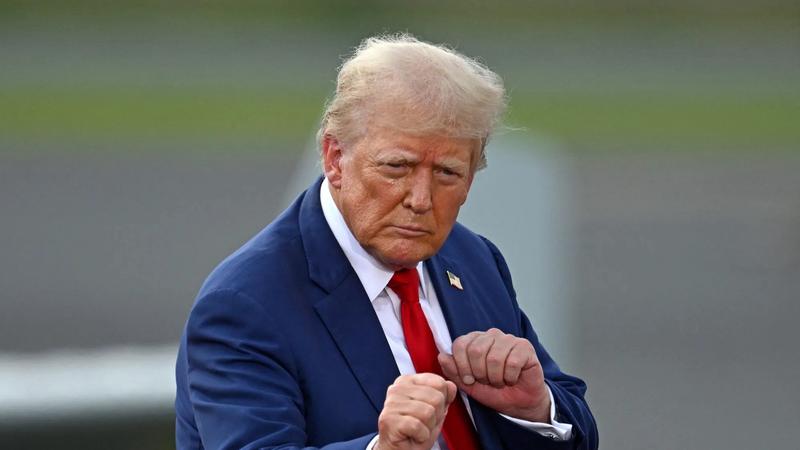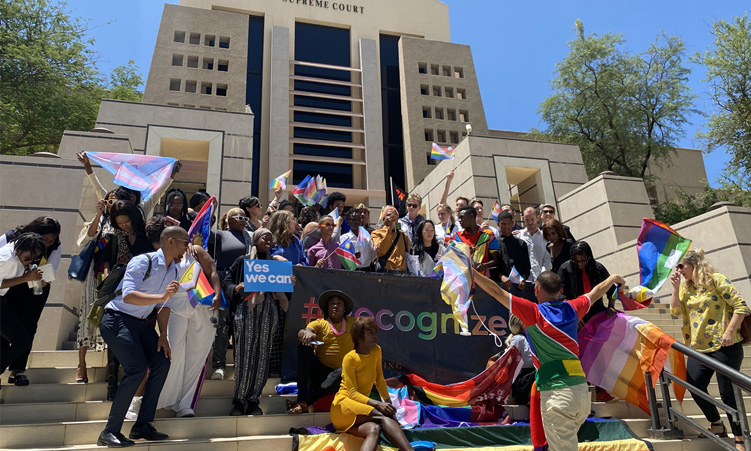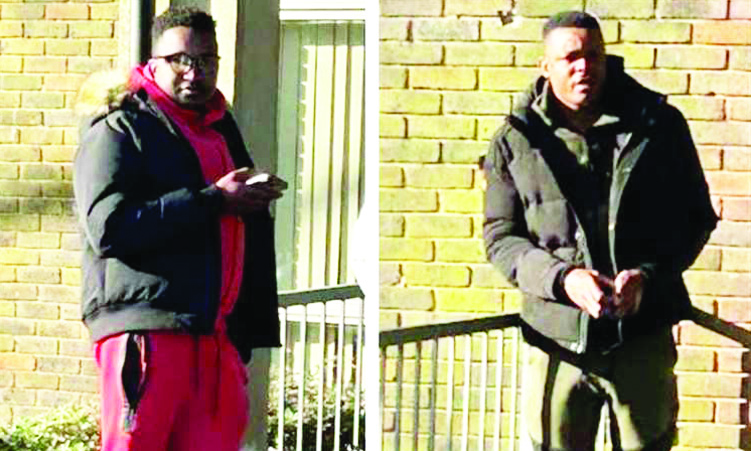I KNOW it is highly unusual for The Namibian to comment on what other newspapers – especially the less credible ones – report, but there is a major public misperception out there that needs to be corrected as a matter of urgency.
So I would highly appreciate it if you allow me to set the record straight, for once and for all. On the front page of last Friday’s edition of Swapo mouthpiece Namibia Today, its editor Asser Ntinda reported on “The Jonathan Cobra Connection” that purportedly shows a connection between myself as “…a former member of the notorious and murderous colonial army, South West Africa Territorial Force and Koevoet (sic)” and the acting president of the Rally for Democracy and Progress, Mr Hidipo Hamutenya.It is an obvious and cheap slur that seeks to utterly falsely connect me to Koevoet, and somehow tie that up with Mr Hamutenya.Its male fide political intent, so shortly before the Swapo Congress, is also glaringly obvious.Needless to say, there are no connections.But at the risk of giving Ntinda credibility, I need to put the record straight because if I am a professional journalist who works for the likes of Reuters, the New York Times, the Mail & Guardian and The Namibian, all highly credible and professional outfits – unlike Ntinda’s newspaper.It is a slur that will make my professional life more difficult, and seeks to falsely and slanderously label me as “traitorous” and “murderous”, while the main and blatantly obvious intent of the article is to smear the RDP and HH as well as somehow being “Koevoets.”It is grossly unfair to all of us, as well as the thousands and thousands of Namibians who HAD to do national service, who suddenly now also are “traitorous” and “murderous.”So it is time to set the record straight, for once and for all.I did my National Service (1988-1989) because the alternative was six years’ jail – but I was never in any way associated with Koevoet or, for that matter, any Military Intelligence unit.In terms of the then-Defence Act, every able-bodied South African male between the age of 16 and 60 was obliged to render five years’ military service, with the first two years full-time and the rest part-time “camps.”Refusal to do so was punishable by six years’ imprisonment, and the vilification and ostracising of you, your immediate family and any known friends.I avoided it as long as I could by doing as many degrees as I could, but in 1987 my third deferment application was rejected and I had to report to SWATF’s Military School in January 1988, as did thousands of others.Half of our intake were not white and many were people who volunteered because they needed a job and there very few options available at the time.I trained and served with many non-white officers – there was no official apartheid here since 1979.I had to do an officer’s course at Oshona, and then served with the 2nd SWA Specialist Forces in Otavi from Sept 1988 to May 1989, when we were finally demobilised in terms of UNSC Resolution 435.I hated being in the army, because it disrupted my life, turned me into a non-person and violated my principles of conscience.And almost everyone I associated with during my stint in the army were equally resentful of a regime that had lost its credibility and demanded we believe their false nationalist myths and prove our loyalty by spilling blood of people we knew nothing about.Arrogance born out ignorance ruled the day, and the dumber and basse classe they were, the more racist they were.The vast majority of people tried to just live around it – but military service was not something you could ordinarily avoid.Politically, the lowest common denominator ruled – and I hope to God we are not going the same way again.And there was no way I could escape, as I come from Okahandja, which was an army town and where the local commander, Col Louis Kotze, was my grandmother’s neighbour in town.It was a parochial, militarised and fascist set-up, intolerant of any dissent and paranoid about hanging on to power…sounds all familiar, does it not? Asser Ntinda gets it totally wrong when he speaks of “SWATF Koevoet” as if they one thing: SWATF was the South West African Territory Force and Koevoet was the specialised so-called Counter-Insurgency unit of the former South West African Police.The two forces did not like each other much; Koevoet’s brand of counter-terrorism was unique to them, and their members were all volunteers, unlike the SWATF national servicemen.In law, the police were in charge of the country’s borders but were suspended by the old SA Defence Act in the late 1970s.When UNSC Res 435 was implemented, the SADF Act was suspended, all military units recalled to base while SWAPOL took over control of the borders again, which is why PLAN’s first clashes (and most, it should be noted) were with Koevoet during that first terrible week of April 1-9, 1989.Asser seems to connect me to a Grobler who WAS in Koevoet and who achieved brief fame when it was reported that he had to cut off his own leg with a knife to avoid being burnt to death when his Casspir was taken out by PLAN RPG-7 during the April 1989 fiasco…and Asser should rather ask why we HAD that fiasco in the first instance.As for the opinions expressed in the Jonathan Cobra columns – which Asser must have been the last journalist to find out that they were written by me, as I admitted freely to it – I was entirely within my rights to express my rather sharp opinions in a way that hopefully contributed to the wider national debate.I am a professional journalist, but also a third-generation Namibian, and I have the right to have a say about how our country is being run.The Cobra columns were also very clearly presented as Opinion, usually printed in the Op-Ed pages, unlike Ntinda’s shocking slander which he represents as positive proof and fact on his paper’s front page, and just before Swapo’s congress this week.The picture published in Namibia Today as proof of the “conspiracy” was taken as I was asking HH for the RDP’s contact details as I have had no contact with him since he was fired so unceremoniously.I was simply doing my job at the rally.There is no conspiracy, but I can’t say the same for Asser, who also circulated and actually made a point of coming to greet me somewhat snidely where I was talking to a colleague.I am now taking legal action against Ntinda, but I need to speak out for the thousands of other Namibians who were in the SWATF and who are now also called “murderous” and “traitorous” – because they are not.A certain faction of the ruling party seems to be of the view that they can dish out or withdraw their peculiar brand of reconciliation and threaten it at the first opportunity when it suits their political purposes.It amounts to political intimidation and incitement to violence, and should be rejected with the contempt it deserves.We are all Namibian.John Grobler WindhoekOn the front page of last Friday’s edition of Swapo mouthpiece Namibia Today, its editor Asser Ntinda reported on “The Jonathan Cobra Connection” that purportedly shows a connection between myself as “…a former member of the notorious and murderous colonial army, South West Africa Territorial Force and Koevoet (sic)” and the acting president of the Rally for Democracy and Progress, Mr Hidipo Hamutenya.It is an obvious and cheap slur that seeks to utterly falsely connect me to Koevoet, and somehow tie that up with Mr Hamutenya.Its male fide political intent, so shortly before the Swapo Congress, is also glaringly obvious.Needless to say, there are no connections.But at the risk of giving Ntinda credibility, I need to put the record straight because if I am a professional journalist who works for the likes of Reuters, the New York Times, the Mail & Guardian and The Namibian, all highly credible and professional outfits – unlike Ntinda’s newspaper.It is a slur that will make my professional life more difficult, and seeks to falsely and slanderously label me as “traitorous” and “murderous”, while the main and blatantly obvious intent of the article is to smear the RDP and HH as well as somehow being “Koevoets.”It is grossly unfair to all of us, as well as the thousands and thousands of Namibians who HAD to do national service, who suddenly now also are “traitorous” and “murderous.”So it is time to set the record straight, for once and for all.I did my National Service (1988-1989) because the alternative was six years’ jail – but I was never in any way associated with Koevoet or, for that matter, any Military Intelligence unit.In terms of the then-Defence Act, every able-bodied South African male between the age of 16 and 60 was obliged to render five years’ military service, with the first two years full-time and the rest part-time “camps.”Refusal to do so was punishable by six years’ imprisonment, and the vilification and ostracising of you, your immediate family and any known friends.I avoided it as long as I could by doing as many degrees as I could, but in 1987 my third deferment application was rejected and I had to report to SWATF’s Military School in January 1988, as did thousands of others.Half of our intake were not white and many were people who volunteered because they needed a job and there very few options available at the time.I trained and served with many non-white officers – there was no official apartheid here since 1979.I had to do an officer’s course at Oshona, and then served with the 2nd SWA Specialist Forces in Otavi from Sept 1988 to May 1989, when we were finally demobilised in terms of UNSC Resolution 435.I hated being in the army, because it disrupted my life, turned me into a non-person and violated my principles of conscience.And almost everyone I associated with during my stint in the army were equally resentful of a regime that had lost its credibility and demanded we believe their false nationalist myths and prove our loyalty by spilling blood of people we knew nothing about.Arrogance born out ignorance ruled the day, and the dumber and basse classe they were, the more racist they were.The vast majority of people tried to just live around it – but military service was not something you could ordinarily avoid.Politically, the lowest common denominator ruled – and I hope to God we are not going the same way again.And there was no way I could escape, as I come from Okahandja, which was an army town and where the local commander, Col Louis Kotze, was my grandmother’s neighbour in town.It was a parochial, militarised and fascist set-up, intolerant of any dissent and paranoid about hanging on to power…sounds all familiar, does it not? Asser Ntinda gets it totally wrong when he speaks of “SWATF Koevoet” as if they one thing: SWATF was the South West African Territory Force and Koevoet was the specialised so-called Counter-Insurgency unit of the former South West African Police.The two forces did not like each other much; Koevoet’s brand of counter-terrorism was unique to them, and their members were all volunteers, unlike the SWATF national servicemen.In law, the police were in charge of the country’s borders but were suspended by the old SA Defence Act in the late 1970s.When UNSC Res 435 was implemented, the SADF Act was suspended, all military units recalled to base while SWAPOL took over control of the borders again, which is why PLAN’s first clashes (and most, it should be noted) were with Koevoet during that first terrible week of April 1-9, 1989.Asser seems to connect me to a Grobler who WAS in Koevoet and who achieved brief fame when it was reported that he had to cut off his own leg with a knife to avoid being burnt to death when his Casspir was taken out by PLAN RPG-7 during the April 1989 fiasco…and Asser should rather ask why we HAD that fiasco in the first instance.As for the opinions expressed in the Jonathan Cobra columns – which Asser must have been the last journalist to find out that they were written by me, as I admitted freely to it – I was entirely within my rights to express my rather sharp opinions in a way that hopefully contributed to the wider national debate.I am a professional journalist, but also a third-generation Namibian, and I have the right to have a say about how our country is being run.The Cobra columns were also very clearly presented as Opinion, usually printed in the Op-Ed pages, unlike Ntinda’s shocking slander which he represents as positive proof and fact on his paper’s front page, and just before Swapo’s congress this week.The picture published in Namibia Today as proof of the “conspiracy” was taken as I was asking HH for the RDP’s contact details as I have had no contact with him since he was fired so unceremoniously.I was simply doing my job at the rally.There is no conspiracy, but I can’t say the same for Asser, who also circulated and actually made a point of coming to greet me somewhat snidely where I was talking to a colleague.I am now taking legal action against Ntinda, but I need to speak out for the thousands of other Namibians who were in the SWATF and who are now also called “murderous” and “traitorous” – because they are not.A certain faction of the ruling party seems to be of the view that they can dish out or withdraw their peculiar brand of reconciliation and threaten it at the first opportunity when it suits their political purposes.It amounts to political intimidation and incitement to violence, and should be rejected with the contempt it deserves.We are all Namibian.John Grobler Windhoek
Stay informed with The Namibian – your source for credible journalism. Get in-depth reporting and opinions for
only N$85 a month. Invest in journalism, invest in democracy –
Subscribe Now!









